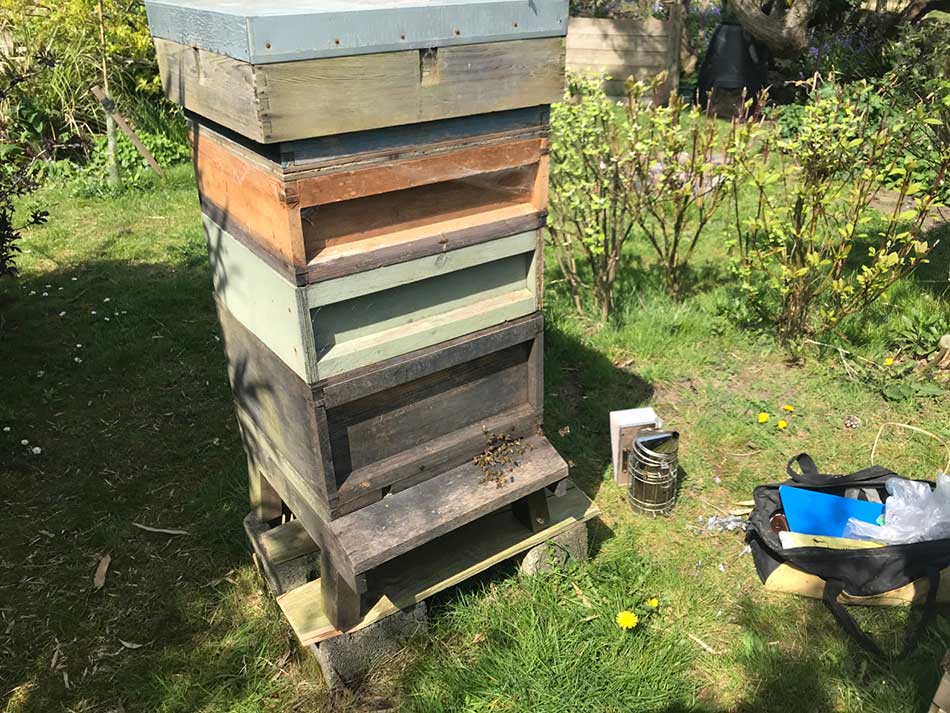A Swarm in May
A swarm in May is worth a load of hay; a swarm in June is worth a silver spoon; but a swarm in July is not worth a fly.
This a proverbial bee-keepers’ saying, from the mid 17th century meaning that the later in the year it is, the less time there will be for bees to collect pollen from flowers in blossom. Or, as I like to think of it, the earlier the better when it comes to swarms.
It doesn’t say what happens if you get a swarm in April, but presumably that’s just as good as there is even more time for them to build up after the fact.
We haven’t quite had a swarm in April, but the bees have been pretty busy at the bottom of the garden lately and were building up quite quickly. I did an inspection yesterday (the last day of April) and as half expected there were signs of swarming. A number of queen cells were being constructed. Time therefore for an artificial swarm.
I wasn’t quite ready to do it so didn’t have all of the equipment in place. Most of the equipment needed a good clean too, but I managed to cobble together a second hive and soon had the artificial swarm completed.
Success Rate
We’ve rarely been successful with artificial swarms. This is usually due to three things.
- The original queen often flies off with a swarm anyway, despite the artificial swarm.
- The newly emerged queens never mate successfully.
- The newly emerged queens subsequently swarm themselves.
This results in the loss of the original queen and therefore a rapid dwindling of that colony. Meanwhile, the new queen never starts laying so that colony often slowly dwindles too until we have nothing left.
The first problem is supposed to be prevented by filling the new box on the old stand that contains the old queen with drawn comb. This gives the old queen plenty of space to lay eggs and should prevent her swarming. I don’t think I did this last night so may need to rectify that soon. Moving the hive a few metres a week after the artificial swarm can also help here as it further reduces the number of flying bees in the colony and therefore reduces the chance of swarming.
I’m not sure there’s anything we can do about the second issue. If there are no drones around for her to mate with there’s little we can do about that. Short of setting up other apiaries nearby. Thankfully though I think there are a number of colonies in an apiary at Ynyslas Gardens. That’s not too far from us so hopefully there will be more chance of a successful mating this year.
The third issue is supposed to be prevented by destroying all bar one of the queen cells in the colony. leaving only one queen cell should prevent cast swarms. Leaving more than one queen cell on the other hand can mean that the first queen to emerge will fly off with another swarm as there are still other queens on the way. I didn’t do this last night as none of the queen cells were that well developed. I may take a look at the weekend though to see how they are looking. If there is a particularly good looking queen cell then I may destroy the others and leave just that one.
Fingers Crossed this Year
Hopefully this year, the fact that we have performed the artificial swarm early in the season will mean that things will go OK. If they don’t then we will at least have a little more time to sort them out. I think I’ll give the new hive with the queen cells in 6 weeks as a maximum. If there isn’t a new laying queen in it by then (the middle of June) then I think I’ll buy a mated queen and introduce her to the colony. In the past we have tried to raise another queen by donating eggs from the original colony but that takes too much time and is still likely to be unsuccessful. At least by introducing a mated queen we will save some time. Hopefully it won’t come to that and all will work as it should so that we can raise our own queen, but if the past is anything to go by the bees will do their own thing and none of it will be want we’d like them to do!














Hi Alan. Welcome to the club! I’ve had to artificial swarm 2 colonies already, and another is superceding (I hope it hasn’t swarmed, but who knows?). Everyone else I speak to is in the same position. It’s clearly been a great spring, and I think that the mild winter was kind to them.
Good luck with the A/S. don’t forget to check the parent colony 4-5 days after you removed the queen. They’ll probably have made some emergency queen cells out of 1-2 day old larvae, which could be capped after 5 days. If you leave more than 1 queen cell then in my experience they will cast swarm. I never seem to find all the q-cells and end up with a few casts each year!
Don’t worry Phil, I had planned to check on them again today. And that’s exactly what I did, despite the chilly temps and strong winds! All was OK in the hive with the original queen and the flying bees. No signs of new queen cells and they seem quite busy and best of all the queen is still in residence!
All OK in the hive with the queen cells too. There were a few queens cells but now only one. Lets hope she manages to mate once she emerges and that we have a good sunmmer from then on. Fingers crossed.
Al.